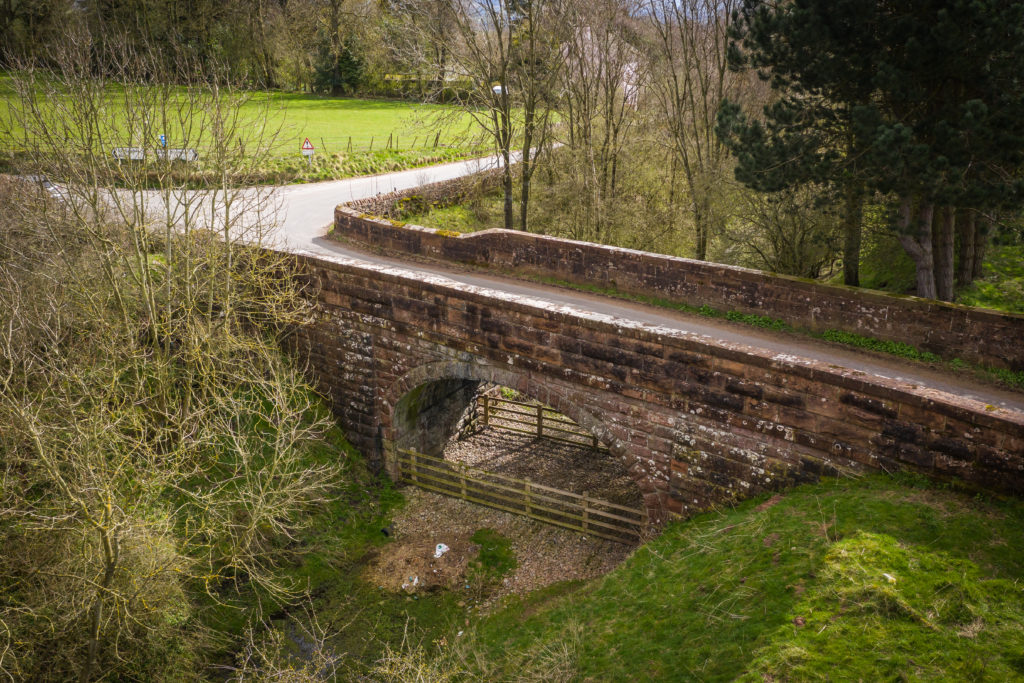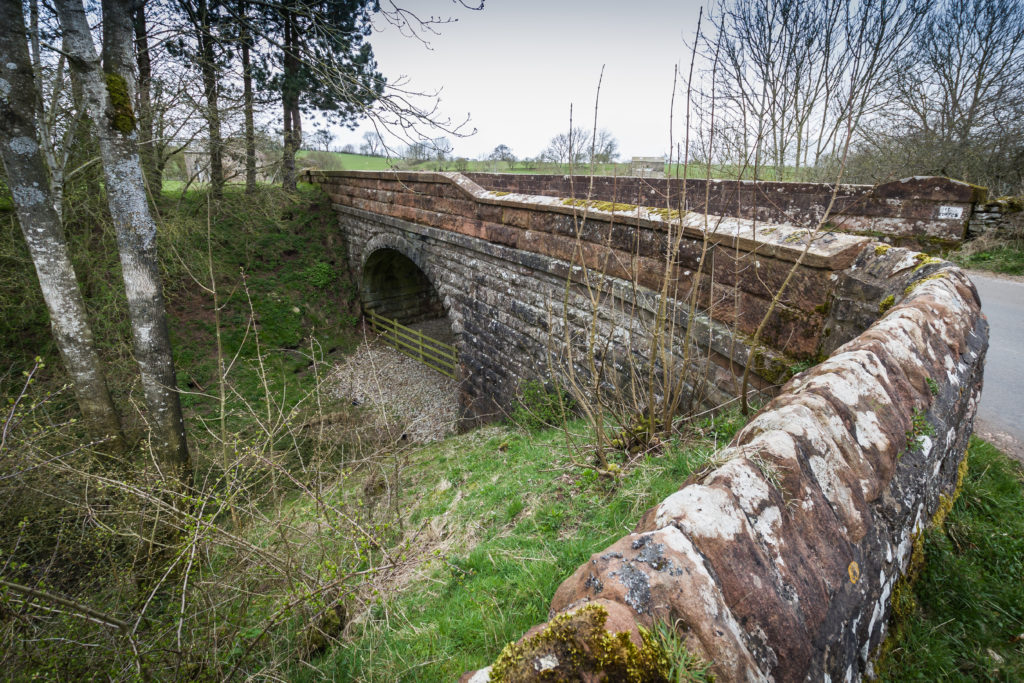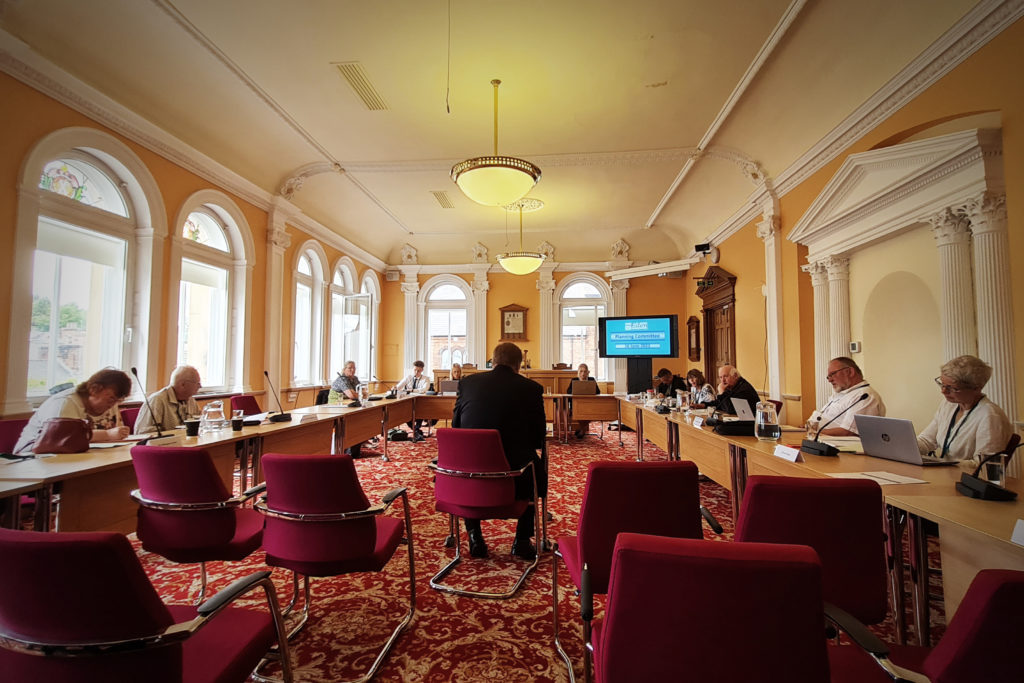Graeme Bickerdike
There are hundreds of old railway bridges much like the one at Great Musgrave in Cumbria’s Eden Valley. The structure emerged from the ground in 1861 through the courage of a few men and perhaps a horse or two, toiling in conditions we can’t begin to imagine. Over 160 years, it became woven into the fabric of the village − a valued part of its history and landscape.
Then, one day, National Highways (NH) turned up and started to bury it in 1,600 tonnes of aggregate and concrete. Not a prior word to the Parish Council or the local highways authority, and no consultation either with the two heritage railways whose longstanding ambition to reunite involved relaying a track beneath the arch.
This was an inexplicable act, unjustified from every conceivable perspective except the narrow one of opportunistic liability reduction. But as the state-owned roads company found itself embroiled in a storm, it constructed an alternative reality which only made matters worse.
A question of strength
In 1998, Cumbria County Council commissioned an assessment of structure EDE/25, known as Great Musgrave bridge. It showed a few modest defects, but the values assigned to mortar loss and profile were overly conservative, resulting in an assessed capacity of just 17 tonnes. More appropriate values would have lifted the modified axle load from 7.5 tonnes to 15 tonnes, well in excess of the 11.5 tonnes for a 44-tonne vehicle.
Repairs were undertaken in 2012 and a detailed examination followed in 2017. The latter recorded some mortar loss and displacement of individual stone blocks in the arch by up to 4mm, but the structure’s condition was described as “fair” whilst National Highways’ scoring matrix found “No significant risk”.
The 2020 visual inspection suggested the maximum deflection of soffit stones was now 15mm (or 3% of their depth), but stated that “all accessible long-standing defects show no evidence of change”.
Again, the bridge’s condition was “fair” and “No significant risk” was presented. A year later, the examiner made clear that “the bridge appears to be in fair condition” and notes “Changes to Existing Defects since Last Examination – None”; however the scoring matrix indicated “High” risk to the public with “Medium” likelihood of occurrence. This sudden and significant change to the perceived risk level was recorded after infilling and had no foundation.

In 2022, National Highways’ retrospective planning application for retention of the Great Musgrave bridge infill − an obligation imposed by Eden District Council (EDC), the local planning authority − claimed that, since 2017, “the joints between the masonry in the arch had again opened up (to 170mm) and that the crown of the arch had dropped (by 15mm)”.
These statements were misleading: the 170mm referred to one isolated perpend joint of no structural consequence, whilst the asserted movement of the arch actually related to a small number of individual stone blocks. The inconsistent method and location of the measurements taken by National Highways’ examiners meant there was no evidence of any worsening of their displacement, an observation supported by the lack of any visible clean stone around their edges. It’s likely some of them had only moved 160 years ago when the timber centring was removed following construction.
Fundamentally, Great Musgrave bridge was fine and contacts within Network Rail suggest they would not have looked twice at it, based on the available engineering reports.
Heavy email traffic
Infilling works began on 24 May 2021. According to an email exchange between National Highways and Eden District Council, contractor AmcoGiffen had set up a compound and cleared “some soft ground” by the morning of 28 May.
Later that day EDC made clear that it was making an assessment “as to whether these works constitute Permitted Development” and asked that “you do not commence with the works until such time as we have made this assessment”. But NH was having none of it: the scheme “will prevent a future collapse and preserve public safety (under class Q). On this basis I am not going to ask the contractor to stop works”, their engineer confirmed.
Class Q powers facilitate temporary works − lasting less than 12 months − in an emergency event or situation “which threatens serious damage to human welfare”, the environment or UK national security. None was applicable at Great Musgrave.
In an email on 24 June, National Highways told EDC that there was “a measured loss of 38% of the mortar in the joints”, but this figure was also misleading, relating specifically to the isolated perpend joint. The company went on to state that the structure “was being overloaded and that works were required to prevent the failure of the bridge and avert a collapse.” This notion was beyond ridiculous.
Bill Harvey Associates – masonry arch bridge specialists – subsequently published a review of the engineering reports, forensically dismantling the case for infilling. It found no evidence to indicate “a current or developing risk of collapse”, whilst all inspections recorded the bridge to be “in fair condition”, as stated by NH’s own examiners. There was nothing to indicate any overloading; indeed exploration using Archie-M, bridge analysis software, suggested the bridge would pass for all AWR vehicles − in other words, it had a capacity of more than 44 tonnes and did not need strengthening.
National Highways used a 24-year-old assessment to inform decision-making despite it being flawed from the outset and then out of date due to subsequent repairs and changes in the codes. It should have been consigned to the archives long since. This failure raises concerns around the company’s asset management regime, whilst claims that a masonry arch bridge might collapse – despite no significant defects – raises uncomfortable questions.
Behind the furore
The campaign against National Highways’ assault on legacy railway structures is led by The HRE Group − an alliance of engineers, sustainable transport advocates and greenway developers. I act as its spokesperson and shoulder most of its workload.
When the issue emerged into the public domain in January 2021, 134 bridges and tunnels were threatened with infill or demolition, with dozens more meeting the same spurious criteria of lacking weight restrictions despite failing their BD21 (CS 454) assessments. No meaningful evaluation had been made as to these structures’ heritage value or potential usefulness as future transport assets.

Ecology reports were produced, but their scope was not sufficiently broad: in 59 pages, the one for Great Musgrave made only a single site-specific reference to “wildlife corridor” in which it argued that badgers would cross the road rather than passing beneath the bridge. Despite a wealth of evidence confirming the importance of dismantled railways for wildlife migration and foraging, National Highways has shown reluctance to recognise it.
For the record, it should be noted that a Stakeholder Advisory Forum has since been established to offer guidance to National Highways on matters relating to its management of the Historical Railways Estate (HRE) − the DfT-owned collection of 3,100 legacy structures − and a new process should ensure that structures requiring major works will, in future, be subject to a more holistic appraisal of relevant issues − ecology, environment, heritage, repurposing, value for money and engineering. At the time of writing, it remains to be seen whether this regime will result in better outcomes as no structures of note have yet been presented for consideration. We can hope though.
What a picture
On 16 June 2021, I headed off to meet contacts at three threatened bridges in Staward (Northumberland), Lochanhead (Dumfries & Galloway) and Kirtlebridge (also D&G). The route home, via the trans-Pennine A66, took me within two miles of Great Musgrave bridge so I disengaged the satnav and turned right. By pure chance, I arrived on the day AmcoGiffen had pumped foamed concrete under the arch and, at precisely 17:59, I took a photograph that changed the campaign’s course.
It was as though the bridge was sick from its fate. Concrete spewed down an ugly bank of aggregate, a squirrel’s footprints embedded within it. Where formerly there had been a delightful masonry arch − fashioned by skilled craftsmen − there was now a blot; an eyesore, imposed without scrutiny by those who could see no value in it. It became the defining image of National Highways’ custodianship of our country’s railway heritage, but they still had the temerity to declare that “through our work we have preserved the structure”. At times, the company has shown regrettable judgement and, despite steps in a better direction of late, rebuilding trust and repairing reputational damage will require it to address that shortcoming.
As the photo appeared on TV, newspapers, specialist magazines, and online, civil engineers lined up to bemoan the shame and embarrassment inflicted on their profession. Then, in July, came the news that the Government had intervened, calling a halt to National Highways’ infilling and demolition programme pending the establishment of “a formalised framework and engagement process for these structures to understand, in each case, whether there is a realistic prospect of it being used for active travel or other transport purposes in future; and to ensure that the views of local stakeholders…are fully taken into account.”
The pause remained in place for about 10 months.
Decision day
Eden District Council’s planning committee convened to determine National Highways’ retrospective planning application on 16 June 2022. In the days leading up to it, I was made aware that NH was offering £450,000 − the supposed cost of excavating the bridge and unnecessarily strengthening it − to refurbish other local structures needed for a proposed heritage railway extension, but only if the infill was allowed to stay. These structures are owned by Railway Paths Ltd (RPL) and I was told at the committee meeting that its director had lobbied at least two members to approve the application.
During the consultation process, RPL lodged one of two supporting submissions; 911 people expressed their objection.
I subsequently asked National Highways for evidence − in the form of an economic benefit study − that such a large investment in assets owned by Railway Paths would represent value for the taxpayer’s money, but the company refused to answer. £450,000 is equivalent to 9.3% of its annual HRE works budget.

At the meeting, I spoke on behalf of those against the application whilst Hélène Rossiter, head of the HRE Programme, represented National Highways. She asserted that “the infill is seen as a small and discreet change”, reiterated the corporate line that “the bridge was weak…deteriorating and significant works were required” and explained that “the process to assess the structure was robust, followed established industry guidelines and was undertaken by experienced and highly-qualified engineers.”
But the Committee was not swayed, rejecting the application unanimously for breaching heritage, environmental and development policies. It was a cause of much surprise that National Highways chose not to appeal against the decision; the infill will go but potentially not until next summer.
Now what?
In a statement, Ms Rossiter said that “We will also no longer consider the infilling of any structures as part of our future plans, unless there is absolutely no alternative.” This commitment leaves no wiggle room and might be one the company comes to regret when its full implications hit home. But it’s been made publicly and, at face value, represents a very substantial change.
So, has a line been drawn? National Highways has proved nothing but unpredictable. A new process − however comprehensive − will make little difference unless it is positively embraced. Despite undoubted efforts over the past few months, there’s been no contrition: the company still seems not to understand why the criticism has been so vigorous.
Making best use of existing assets is already being recognised as a must in tackling our emerging economic crisis. Legacy structures have a role to play, but can only do so if their custodian’s stewardship is sensitive and sympathetic.
Image credit: The HRE Group

